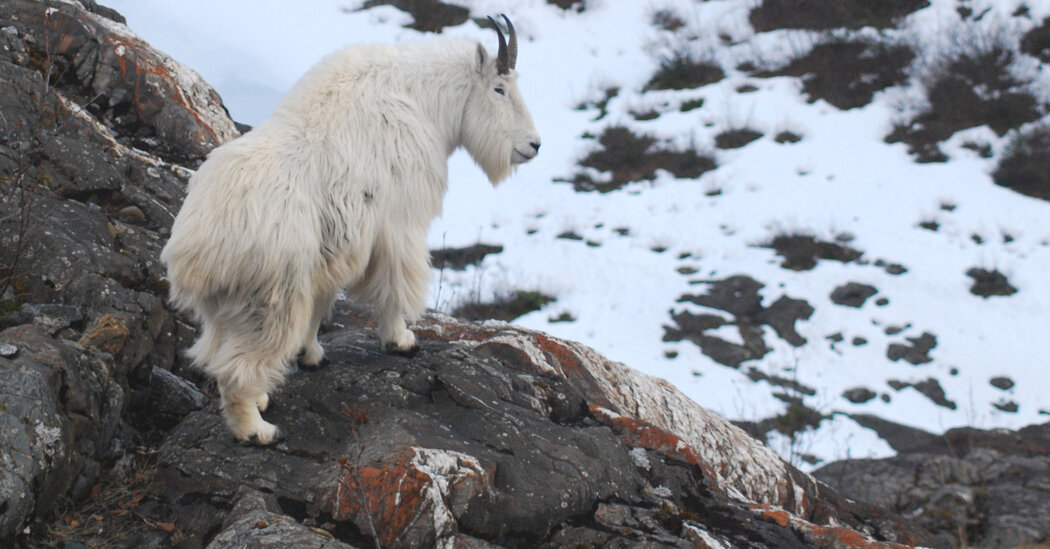The scene ends badly, as you might imagine.
Mountain goats are high-elevation daredevils, learning to balance upon the steepest of rocky edifices soon after they are born. Nannies lead their kids up gnarly slopes, seeking places that predators fear to tread. While the precarious perches help goats avoid being eaten, there is an obvious downside to these sanctuaries: avalanches.
While scientists have long suspected that this life on the edge was risky, they have not really understood the extent to which avalanches affect mountain goats, and whether they instinctively shun, or can learn to avoid, avalanche-prone conditions. While the behavioral question remains a mystery, a study published Monday in the journal Communications Biology, based on nearly two decades of research in Alaska, shows that cascades of snow are a major killer, substantially affecting the animals’ populations.
Kevin White, an ecologist at the University of Victoria and the University of Alaska Southeast and lead author of the study said, “We’ve often thought of snow as a major driver of populations,” of mountain goats. But the difficulty of studying their rugged, inaccessible habitats has limited understanding of what avalanches do to the animals’ numbers. That is compounded by a bias toward summertime research on the animals.
Typically, “people don’t go out in the winter, and they don’t go out in these conditions,” said Eran Hood, a snow hydrologist at the University of Alaska Southeast and an author of the study.
Over 17 years of field work with the Alaska Department of Fish and Game, Mr. White fitted radio collars on 421 goats in the Klukwan, Lynn Canal, Baranof Island and Cleveland Peninsula regions of southeastern Alaska. He surveyed the animals’ locations, following their movements from aircraft as the pulsing collars indicated whether the goats were alive or dead. When mortality was detected, Mr. White swooped in by helicopter. Then, if it was safe to land, he gathered post-mortem clues. Then he worked with a group of colleagues to make sense of the mortality data.
Data from the collared goats revealed that snow slides barreled down not just on inexperienced kids but on breeding adults as well, especially females in their prime. Avalanches were deadly, explained Mr. White, and caused 65 percent of all deaths in one of the regions studied.
In southeastern Alaska overall, “it could mean that 8 percent of the population, on average, is dying from avalanches; and in some of the worst years, it was over 22 percent,” Mr. White said. He concludes that “avalanches may be a much more important driver of populations than previously expected.”
Fanie Pelletier, an ecologist at Université de Sherbrooke in Quebec who studies bighorn sheep, and was not involved in the goat study, was surprised by the high avalanche mortality rate. With so many individuals monitored over 17 years and data drawn from four sites, she called the study “robust.”
Elizabeth Flesch, a wildlife geneticist at Montana State University agrees. “It’s pretty impressive they were finding collars under avalanche debris,” she said, noting that in survival studies, assigning the cause of death is often difficult.
That these avalanches were burying prime-age females “is a really big deal,” said Dr. Flesch, who was also not involved in the study, because when females are disproportionately removed from a population, recovery is slow.
Wesley Sarmento, a mountain goat expert at Montana Fish, Wildlife & Parks, called the study innovative. “Mountain goats are particularly susceptible to climate change, so more of this kind of research is important,” he said. But he cautioned that it remains to be seen whether the patterns in southeastern Alaska hold true elsewhere.
Pia Anderwald, a researcher with the Swiss National Park in Zernez, Switzerland, who studies antelope-like chamois and other hoofed Alpine mammals, was not surprised by the number of goat avalanche deaths in the study. She added that because only adults were collared, “kids and yearlings may have been underrepresented.”
She also doubts the researchers’ conclusion that goats can’t learn about avalanche risk. As a species that evolved in this terrain “I’d be surprised if they didn’t have any means of assessing dangerous areas,” she said. “They watch each other.”
And as climate change affects snowfall patterns and the future likelihood of avalanches, the goats will need to keep an eye on that too.
Indeed, avalanches are not new. So Mr. White’s next challenge is to determine why goats court such danger. He suspects that if the costs of clambering in risky places are high, the benefits — such as fewer predators, and fabulous food — must be high, too. No kidding.
